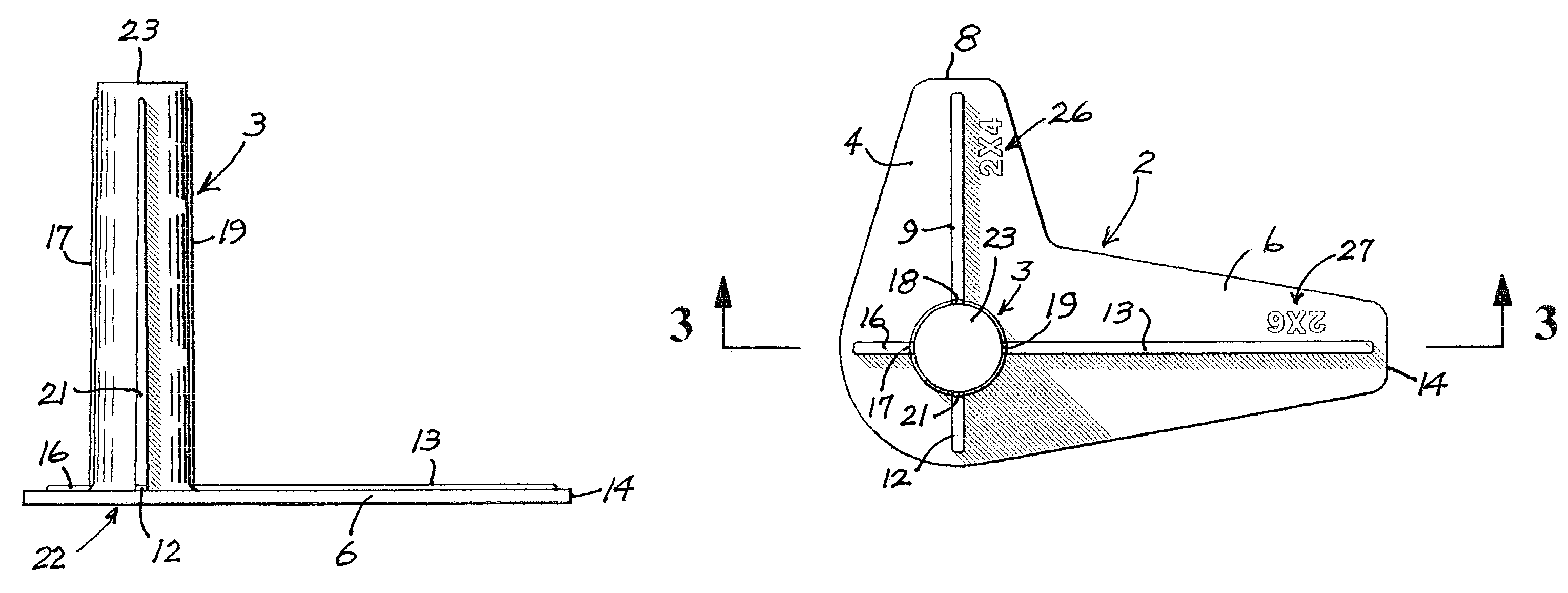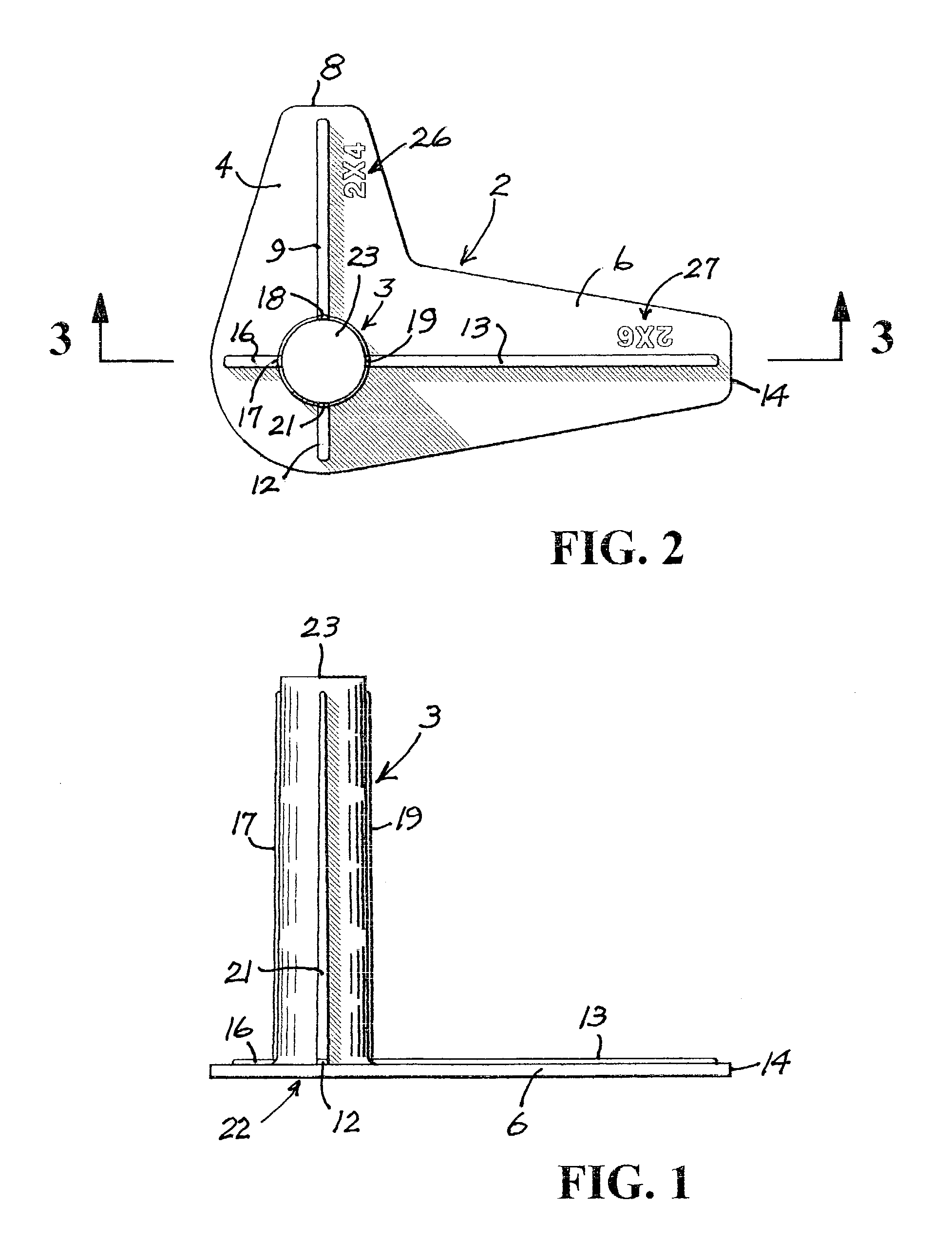Anchor bolt placement and protection device
a protection device and anchor bolt technology, applied in the direction of buildings, buildings, constructions, etc., can solve the problems of inconvenient placement of anchor bolts, inconvenient installation, and high labor intensity of workers, and achieve the effect of preventing thread contamination
- Summary
- Abstract
- Description
- Claims
- Application Information
AI Technical Summary
Benefits of technology
Problems solved by technology
Method used
Image
Examples
first embodiment
[0032]Referring to FIGS. 1 through 12 that embody and illustrate the anchor bolt positioning or placement device of the invention, it is noted that this embodiment is a pre-manufactured unitary or monolithic device injection molded from an appropriate synthetic resinous material that is tough and impact resistant, such as a phenolic, and is formed to provide a flat base portion designated generally by the numeral 2 and an integral vertically extending generally tubular projection integral with the base member and designated generally by the numeral 3. As seen in FIG. 2, the base member includes two laterally extending integral plate portions 4 and 6 extending at right angles to each other. The center lines of the two plate portions, if extended, would cross coincident with the central axis of the tubular projection 3. The extension 4 is utilized to measure the distance from the inner face of the form board or the outer face of the concrete foundation wall or the outside edge of a co...
second embodiment
[0038]From FIGS. 13 and 14, it will be seen that in this second embodiment of the invention the anchor bolt placement device is again provided with a vertically extending tubular member designated generally by the numeral 41, having the same configuration as the tubular projection 3 illustrated in FIG. 4, including the an open bottom end 22, a closed or otherwise terminated end 23, the reinforcing ribs previously mentioned and the radially inwardly projecting annular rib 32 adjacent the open end 22. This embodiment of the invention differs from the embodiment illustrated in FIGS. 1 through 5 in that the measurement means for determining the proper position of the anchor bolt for 2″×4″ and 2″×6″ mud sills are incorporated in a single laterally projecting elongated plate designated generally by the numeral 42. This is in distinction to the two lateral extensions 4 and 6 spaced 90° apart as illustrated in FIG. 1. Referring to FIG. 13, it will be seen that the single lateral extension p...
third embodiment
[0039]Referring to the invention illustrated in FIGS. 15, 15A and 16, it will be seen that in this embodiment of the invention the lateral extension constitutes an elongated base plate designated generally by the numeral 51 integral with the upwardly projecting tubular member 52 the structure of which is the same as the upwardly projecting tubular member 3 illustrated in FIG. 14. In this embodiment, the elongated base member 51 projects to the right of the upwardly projecting member 52 as seen in FIGS. 15 and 16 in a base portion designated generally by the numeral 53, this portion of the base having a central reinforcing rib 54 that extends medianly of the base to adjacent the end edge 56 of the elongated base member portion 53. Positioned on the top surface 57 of the base member portion 53 are laterally spaced transversely extending position-indicator ribs 58, 59, 61 and 62, each of these ribs being spaced apart one from the other approximately one inch. Note also that between the...
PUM
 Login to View More
Login to View More Abstract
Description
Claims
Application Information
 Login to View More
Login to View More - R&D
- Intellectual Property
- Life Sciences
- Materials
- Tech Scout
- Unparalleled Data Quality
- Higher Quality Content
- 60% Fewer Hallucinations
Browse by: Latest US Patents, China's latest patents, Technical Efficacy Thesaurus, Application Domain, Technology Topic, Popular Technical Reports.
© 2025 PatSnap. All rights reserved.Legal|Privacy policy|Modern Slavery Act Transparency Statement|Sitemap|About US| Contact US: help@patsnap.com



